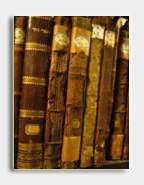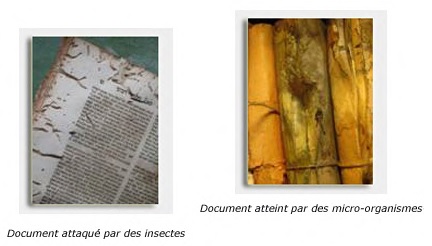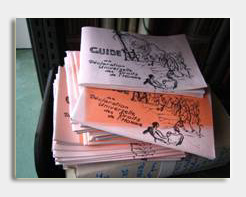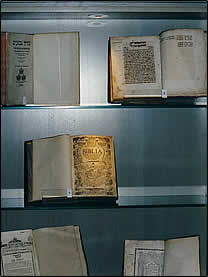Bibliothèque
The library at the AIU has followed its own path of development, paralleling that of the AIU academic network. Originally located at Rue de Trévise in Paris, in the Central Committee's conference room, the library eventually moved to l’Ecole normale israélite orientale’s building on rue Michel-Ange, built in 1904.
|
It was in 1937 that the library moved to its current location on rue La Bruyère. With both a reading room and several storage rooms, this new location facilitated frequent visits.
In the spring of 1940, just after the collapse of Paris, the Nazis invaded the Alliance’s building and moved 700 boxes of books, archives, manuscripts, and periodicals to the Institute for Study of the Jewish Question in Frankfort.
|
|
While the Nazis continued their systematic killing of the Jewish people; a fantastic collection of Jewish Books were stored away.
At the time of liberation, American Troops gathered at Offenbach to recuperate all of the books and other precious objects and documents that had been stolen by the Nazis. Other European libraries also were able to pick up their own. Many of the books that the Alliance retrieved from Germany still carry the stamp of the Institute for Study of the Jewish Question.
The collections and catalogs were reconstructed during the years following the war. The renewed success of Jewish Studies in France and the growth of the library motivated the library’s renovation, which started in 1989.
An exceptional Heritage
Since it was founded; the Alliance has functioned under 3 axis:
- The acquisition of remarkable pieces concerning literary hebrew heritage
- The establishment of a collection of works that originate from the best rabbis and universities that the world of Jewish Studies has to offer
- The collection of interesting documents from everyday Jewish life and the history of various Jewish communities
It is among these disciples of Jewish Sciences in France that the first staff members were recruited:
Isidore Loeb (1839-1892) and Israel Levi (1856-1936) were the pioneers of the construction of collections, paving the path for their successors.
The great Rabbi Julien Weill (1873-1950) Isiodore Lévy, Professor at the Collége de France (1871-1954) Abraham Back Professor at l’Ecole Rabbinique (Rabbinical College) (1878-1947) Jacob Gordin, philosopher (1896-1947), Edmond-Maurice Lévy, honorary curator of the library of the school of industrial arts, (1878-1974), Colette Baer; Jeanine Harburger, Georges Weill, Yvonne Lévyne, Jean-Claude Kuperminc. In the world of Jewish heritage, they scout out and eventually acquire almost all of the Jewish works available in Europe. This explains the fact that in the collections, one can find works from the 16th, 17th, and 18th centuries in French, Latin, and Hebrew. Copies of the Bible in Hebrew as well as other languages, as well as the Hebrew commentary make up the heart of this part of the collection, wherein one can also find copies of the Talmud and other Jewish codings.
One can also find rabbinical consultations concerning the evolution of religious law in these collections. Prayer books including pictures of Easter rituals, which are among some of the library’s most remarkable works, are also available.
Thanks to the generosity of our donors (such as L.M Rothschild, a Danish Jew who originally financed the library in 1867), as well as various generous gifts, the AIU has equipped itself with one of France’s best Hebrew manuscripts: that of scholar Samuel David Luzzato. Also included in this collection are a few marriage agreements (ketoubot) from the XVIIIth century, which are testiomony of a more popular art form.
Another excellent collection consists of 4000 fragments from Geniza of Cairo. These fragments have belonged to the AIU since the beginning of the 20th Century. Following the example of about fifteen other libraries around the world (such as The University of Cambridge, Oxford, and Saint Petersburg), the AIU made an effort to preserve these scattered pieces of Hebrew and Arab writings originating from the ancient synagogue in Cairo, where they had been stored since the middle ages. In fact, these documents were discovered discovered only in 1897 by Salomon Schechter.
One of the most precious collections results from the legacy of the Great Rabbi of France, Zadoc Kahn. The collection contains books and booklets in both Hebrew and Latin characters. Hundreds of these booklets cannot be found elsewhere.
The academic texts written by 19th century Jewish Sciences writers, and their 20th century successors, constitute another strong section of the library. In German and in French for the most part, these books and periodicals written by scholars such as Léopold Zunz, Abraham Geiger or Moritz Steinschneider and their French colleagues, as well as those coming from large universities such as Darmester, Reinach, and plenty others, were regrouped at the AIU so that other researchers can have access to them.
An international Research Center
Historical Studies, translations, copies of texts, and bibliographies from the current era are still important research tools for those interested in Jewish studies. The library at the AIU understands this need for, and makes a great effort to acquire the most important books written by 20th century scholars. It was during this time, after all, that the definition of Jewish Sciences was set in stone. The works, the majority of which come from the United States or from Israel, are not usually accessible in other French libraries.
The third part of the AIU Library’s heritage, the documents concerning everyday life and the history of the French Jewish people is an important source for historians. It is especially well illustrated through the complete collections of the the newspapers “Les archives israélites” and “L’univers Israélite”, which are available in the library’s reading room. These two French periodicals, covering an entire century, (1840 to 1940), are an important source of information on Jewish life in France during this essential period in time. After 1945, scholars embarked on new subjects of research: the ways in which Jews adapted to the consequences of the Holocaust, the reconstruction of the Jewish Community, as well as the mass arrival of Jews from North Africa constituted the areas of study of students.
Archives
Another unique element of the heritage of the library is the AIU archives from 1860 to 1940, which have been used for serval theses and other academic works throughout the world. These archives illuminate not only the history of the Alliance and its schools across the world, but also traditional Jewish life in Eastern ghettos, Jewish neighborhoods in North Africa, anti-semitism and relations with non-jews, competition with colonial powers, and Jewish morals in relevant countries.
Today, the library remains faithful to its missions: perpetual growth of collections, conservation of heritage, and communication with outside sources about the collections. The AIU has also allowed itself to be enhanced by the technological revolution. Since 1996, the library has made us of the software system ALEPH, which allows it to manage books and catalog Hebrew documents in the Hebrew language. In addition, other technologies (internet, CD Roms, etc) have allowed the library to consult other libraries in France and across the world
Heritage library, open to a wide variety of individuals interested by Jewish Studies, internationally known...The AIU Library is pursuing its mission to establish a Jewish presence in National Heritage.
Special Collections
• Fonds Marianne Harburger Jewish and Hebrew Medicine
• Fonds Georges Vajda Jewish Philosophy in Islam
• Fonds Jacob Gordin Jewish Germanic and Russian Philosophy
• Fonds Pierre Haïat Jewish poetry
• Bibliothèque juive contemporaine Jews from ’URSS from 1969 to 1989
• Fonds Jacqueline Genot-Bismuth.
• Fonds Yitzak Zohar
• Fonds Marc Knobel
• Fonds Zadoc Kahn.
Preservation of Documents in the AIU Library
What does the preservation of documents involve?
The preservation of documents (books, archives, objects,) means doing everything we can to assure they live the longest life possible. They must be kept in optimal condition and handled in the best possible way so that they don’t age prematurely. This care must also be ensured when transferring documents elsewhere for outside consultations.
Precautions to take when handling documents
In order to ensure that the documents available to visitors maintain the longest possible lives, there are certain rules one must respect when consulting books and archives. These rules are printed in a guide given to each new visitor.
- Factors that impact deterioration
|
Documents often deteriorate because of the way in which they are handled. However, they may also be damaged due to the way in which they are stored. |
 |
-Physical Alterations (paper, parchement, leather)
This includes damage done to the materials themsemves, such as rips, tears, and other deformations that occur due to improper handling or sorting.
Chemical Alterations
This includes alterations to the internal structure of the document. For example, when the acidification of a piece of paper causes it to turn yellow. This occurs because the paper contains lignin (wood).

Hydrothermal Conditions
The conditions in which the documents are kept are essential to their upkeep. No one type of document has the same “ideal” storage environment. The ideal temperature is between 18 and 20 degrees Celsius. The ideal percentage of humidity should be between 20 and 50 percent depending on the material of the photographs (glass, copper, paper, etc)
Dust Removal- How? Why?
An essential part of the preservation process is the removal of dust. Dust is abrasive and contains spores of microorganisms. This means one must regularly clean the rooms in which the documents are stored, dust the shelves, and dust the books.
The manufacturing of 4 inside cover pockets
Each supplier has his or her own standard format for the pockets of inside covers. However, custom made pockets are constructed for very fragile works. They are made with permanent paper (basic pH, alpha cellulose, very few wood components).
The consequences of artificial and natural light on the document
 Light is an important factor that contributes to the deterioration of documents, be it by sunlight or artificial light. Light is made up of three categories: The first is that which is visible to the naked eye, between 400 and 700 nanometers. It is measured in Lux (nM). The second is infra-red light, or thermal light (heat). |
|
The shorter the wavelength is, the more energy it produces.
At a time, the documents were exposed to light for an extended period of time. As a result, some of them have either dried out or yellowed. In response to this, the library installed special curtains in the reading rooms so that all natural light can be avoided. Only fluorescent lamps emit light. For all extra information, you may contact Amélie le Ray, preservation supervisor for the library.
amelie.le-ray[at]aiu.org

